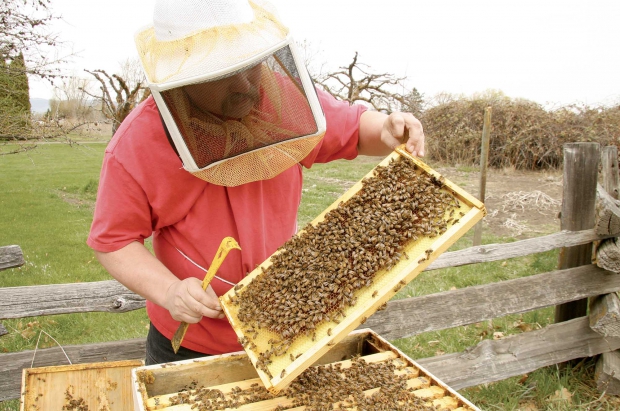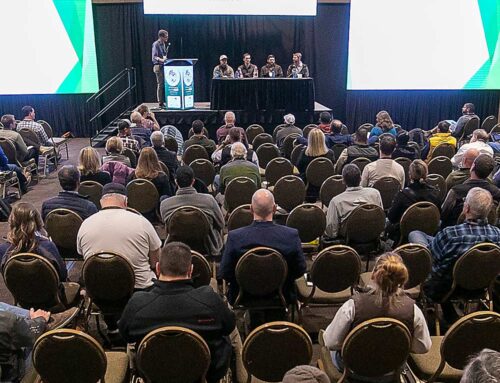Neonicotinoids are under international focus for their impact on honeybees, but not all the blame for declining bee populations can be placed on that pesticide class.
Honeybee decline is real and is a major concern, says Dr. Timothy Lawrence, Washington State University extension educator. Since 2006, European and U.S. beekeepers have reported dramatic declines in honeybee colonies, a phenomenon that’s gained international attention.
The cause of the decline, named colony collapse disorder, has been the subject of numerous studies. Of late, researchers have been looking for a connection between chronic exposure of bees to neonicotinoids in nectar and pollen and plant water picked up by foraging bees and brought back to hives.
Lawrence has been involved with the bee industry for more than 50 years, starting with his first beehive when he was 12 years old. He’s worked in all aspects of the bee industry, from beekeeper to research associate in WSU’s Honey Bee Health Program. Since 2010, he’s been director of Island County WSU Extension, based in Coupeville.
The decline is concerning, he said, because the U.S. bee industry has grown into a billion-dollar business and provides important pollination services for orchardists and other growers.
The almond industry is particularly dependent on pollination. More than half of the nation’s honeybee colonies are trucked into California each February to pollinate some 800,000 acres of almonds, a crop that uses up to 2 million colonies annually, according to Lawrence.
California’s ever-increasing almond acreage and the recent harsh winter conditions will put a squeeze on beehive supply in 2014 for almond pollination. Almond growers reportedly pay up to $200 in rent for each hive.
Toxic world
Factors relating to colony decline are varied and include lack of genetic diversity in the queen breeding lines, farm monoculture, loss of habitat, selenium toxicity, supplemental honeybee feed sources, air pollution, pesticides, and more. From the eyes of a honeybee, the modern world is toxic.

Dr. Timothy Lawrence
“There are more than 60 variables associated with CCD, none of which is a definitive cause,” Lawrence said during the Cherry Institute meeting in January in Yakima, Washington. Honeybees experience numerous environmental and chemical stresses, some from their own keepers.
“In my opinion, the biggest issue playing a role in CCD is Varroa mite (Varroa destructor),” he said, explaining that the parasitic mite is directly and indirectly responsible for the loss of tens of thousands of honeybee colonies each year. The tiny mite feeds on the circulatory fluid of honeybee adults, pupae, and larvae. “If beekeepers don’t treat their colonies for Varroa mite, the bees are guaranteed to be dead within two years.”
Beekeepers are in a difficult position. To combat the mite, many treat their hives with pesticides like fluvalinate, coumaphos, and amitraz. While they can’t make money on dead bees, the very chemicals they use for Varroa mite are often found in commercial honeybee wax and pollen. WSU research shows that these Varroa mite pesticide residues—often the highest of all pesticides detected in the wax and pollen—stay in the colony for long periods of time.
While there are alternative means to control Varroa mite, such as biological pesticides, mite-tolerant breeding stock, and mechanical control, the methods are time consuming and not always as effective.
Another beekeeper-induced stress on honeybees is the intense management practice of supplemental feeding.
To ensure strong colonies for almond pollination in late winter, beekeepers in some regions feed thousands of colonies pollen substitute and sugar syrup. Studies show this feedlot feeding may reduce the bees’ ability to detoxify pesticides and make them more susceptible to some pesticides.
U.S. Department of Agriculture scientists have found a host of pesticides and chemicals in bees’ wax in colonies across the country, according to Lawrence. He said that some believe surfactants brought back to the colony may be more detrimental than pesticides.
Pathogens are also responsible for bee death and decline, he said. Pesticides to control Varroa mite and some neonicotinoids are believed to make bees more susceptible to diseases that in the past were not a problem. Black queen virus is an example of a disease that has flared up in California bee colonies.
Neonicotinoids

Beekeeper Justin Vincett of Ellensburg, Washington, holds a frame of honeybees. (Melissa Hansen/Good Fruit Grower)
Neonicotinoid pesticides have become one of the fastest growing classes of pesticides used in agriculture as well as in home and garden products because they have low mammalian toxicity and stay confined within the plant, working systemically. “They’re relatively safe for use around people, animals, and the environment and are considered good products from an environmental and safety perspective,” he said.
More than 465 neconicotinoid products are approved in Washington State, with 150 approved for home and garden use, according to Lawrence. But their systemic nature poses a problem with bees. “The pesticide moves throughout the plant and is in the plant’s phloem, xylem, and even in the nectar,” he said.
In lab experiments, scientists have found that some neonicotinoids are lethal or sublethal to bees, depending on exposure. Dust from seeds treated with neonicotinoids can have an acute effect on bees, and spraying neonicotinoids when bees are foraging will also result in quick death. However, the bigger concerns are the sublethal effects from neonicotinoids, he said.
“There is growing concern for chronic exposure through nectar, pollen, and water picked up and carried back to the hive by foraging bees,” stated Lawrence. Sublethal effects attributed to neonicotinoids are impaired learning, altered foraging and motor activity, and memory loss.
“Neonicotinoids are part of the overall problem—they do have a negative effect on honeybees—but they are not the sole problem,” he said. “It’s not any one thing that’s responsible for honeybee decline.”
What’s needed to stop the declining bee populations? He recommended that tree fruit growers avoid spraying during bloom and be more conscious about bees and how to protect them.
Also, more research dollars are needed to better understand the interactions of various stresses on bees and to develop new products that have minimal impact on honeybees and other pollinators.
But what bees really need, he said, are more flowers. Bees have lost habitat and diversity from urban sprawl and monoculture practices of growing one crop in large blocks. “Bees need floral diversity to supply nutrients and stimulus. If we want to solve the honeybee problem, we need to plant more flowers.” •






Leave A Comment